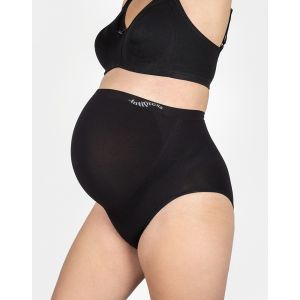Yoga during pregnancy · All you need to know


Yoga is one of the most recommended activities for pregnant women. It helps you prepare for delivery through breathing and postures that exercise your pelvic muscles. Do you have questions about how to start? In this post, we tell you everything you need to know.
What benefits can yoga bring me during pregnancy?
- Reduces stress. There are many times during the nine months that you are going to feel stressed and anxious. Practising yoga frequently will help you disconnect, maintain emotional stability and rest better.
- Helps you prepare for childbirth. Yoga includes a series of body postures that strengthen and open the pelvic area so that the efforts you will make in childbirth will not be so complicated. Yoga is also based on breath control, an aspect that you will need to master on the day of the baby's arrival.
- Better postpartum recovery. Doing this physical activity both before and after childbirth will improve your blood circulation and strengthen your muscles. In addition, there are postures that work the perineum area that will speed up your recovery.
What type of yoga is the best for pregnancy?
There are different types of yoga that can be practised. Before knowing our recommendations, get to know some of the most popular:
- Hatha Yoga: It is the ideal practice if you are starting in this world. The fundamentals of yoga are covered: both in postures (asanas) and breathing (pranayama).
- Vinyasa Yoga: This is one of the variants where you seek to strengthen the muscles from more advanced level postures.
- Kundalini Yoga: It is a practice focused on meditation and mantras. It is a good option for you if what you prioritize the most is to reduce the level of stress or anxiety.
- Iyengar Yoga: It is an ideal modality to gain flexibility and recover from injuries. Body postures are worked on slowly and deeply to perfect them.
- Bikram Yoga: This style is practised in rooms at 40ºC to eliminate arterial blockages, avoid heart problems and increase breathing capacity. It is demanding and some of the postures are considered a bit aggressive.
- Ashtanga Yoga: The most related to Vinyasa. It is also physically demanding and helps to strengthen the upper body.
- Yin Yoga: It is the most similar option to Kundalini Yoga and tries to include meditation to reduce tension.
- Acroyoga: It is the modality that combines acrobatics with yoga and is performed with at least two people. It can help you to strengthen your body and gain confidence with your partner.
There are four highly recommended modalities if you want to start yoga during pregnancy: Hatha Yoga, Kundalini Yoga, Yin Yoga and Acroyoga. The first style will provide you with the foundations of this physically and mentally rewarding activity. The second and third options will be useful for you to find calm in times of stress. And the last alternative is the best to practice with your partner.
What material do I need to do yoga during pregnancy?
Yoga is an activity that you can do at home and you may already have everything you need to start practising it. Below we review the basic material to get you started with yoga postures for pregnant women:
- Mat. There are simple ones that you can buy for less than €20. The most important thing is that the one you get is non-slip. This will allow you to do the different postures comfortably and safely.
- Comfortable pregnancy clothes. It is important that you can carry out all the sessions feeling comfortable and relieved. You must equip yourself with garments that are breathable and support your lower back. Antipress maternity briefs are ideal for yoga.
- Music. The most common thing during yoga is listening to relaxing songs. Especially when you do sessions and postures of more restorative and meditative modalities, you will appreciate hearing this type of melodies. Nevertheless, it is a very personal choice.
- Cushion (optional). The zafu is the cushion used in some styles of yoga. It is ideal for maintaining an upright posture during meditation.
What yoga poses can I start doing if I am pregnant?
There are some simple postures highly recommended for pregnant women. You can start with these five:
- Malasana or Garland pose: It consists of bending the knees keeping the upper body upright and the feet facing outwards. It will help you open your hips and strengthen your lower back and abdomen.
- Sukhasana or easy pose: It is a perfect option for all phases of pregnancy. It involves crossing your legs while sitting on the floor. It is useful to keep practising meditation and seek calm.
- Bitilasana or cow pose: Keep your hands and knees on the ground trying to keep your back completely parallel to the surface. Lower your belly as you exhale and push it back up as you inhale. You will strengthen your arms and back muscles.
- Marjaryasana or Cat Pose: This pose complements the Bitilasana or Cow Pose. They are usually done together. It makes the spine more flexible and strengthens the pelvic floor.
- Baddha Konasana or Cobbler’s pose: Preparing for childbirth you will want to increase flexibility in the knees, work the inner muscles of the legs and open the hips. This alternative is one of the most recommended during the last trimester of pregnancy. Just sit down and try to bring the soles of your feet together as close to your body as you can.
How often is it advisable to practise yoga during pregnancy?
Prenatal yoga is a less demanding activity than other sports that are also recommended during pregnancy, such as swimming, cycling or running. Your physical condition and your predisposition to exercise will determine how often you will do it. There are women who spend between 15 and 30 minutes for each session on a daily basis, but there are also those who prefer to do longer but more sporadic sessions. Find your balance and feel comfortable. What we do suggest is that if you want to start and learn to do the postures, do at least three sessions of about 30 minutes each week. When you have created the habit, in a few months you will notice a huge improvement.
How can I learn more about yoga in pregnancy?
We leave you with 3 resources that will be very useful to learn some postures in more depth:
- Prenatal yoga for beginners - Marina Buedo shares a lot of knowledge in a 35-minute video.
- Yoga for motherhood, childbirth and beyond - 160 pages of pure yoga in a book published in 2020 and written by Françoise Barbira Freedman
- Yoga for the third trimester of pregnancy - Lucía Liencres did a 50-minute session focused on the most appropriate postures for the last three months.



